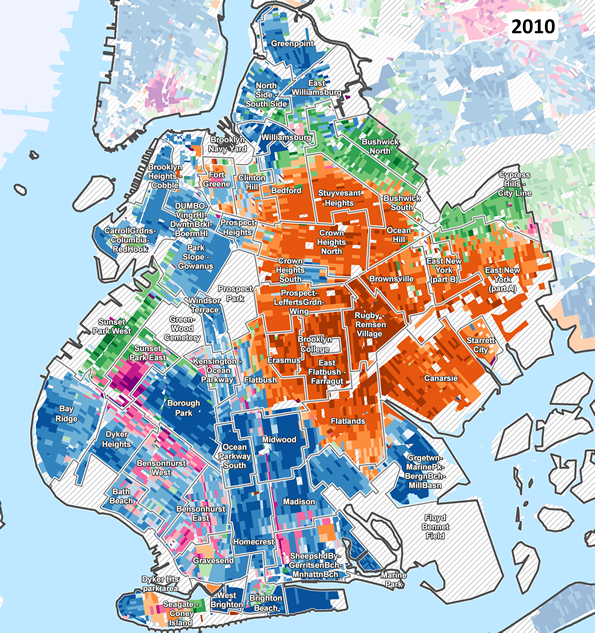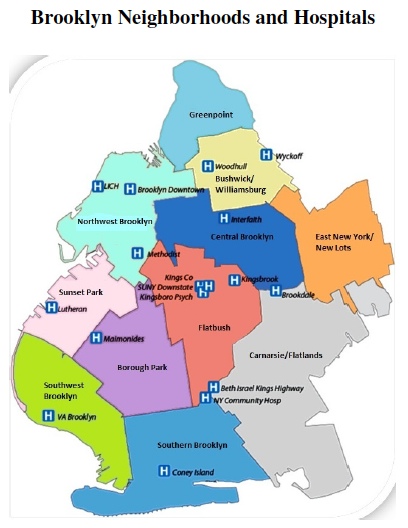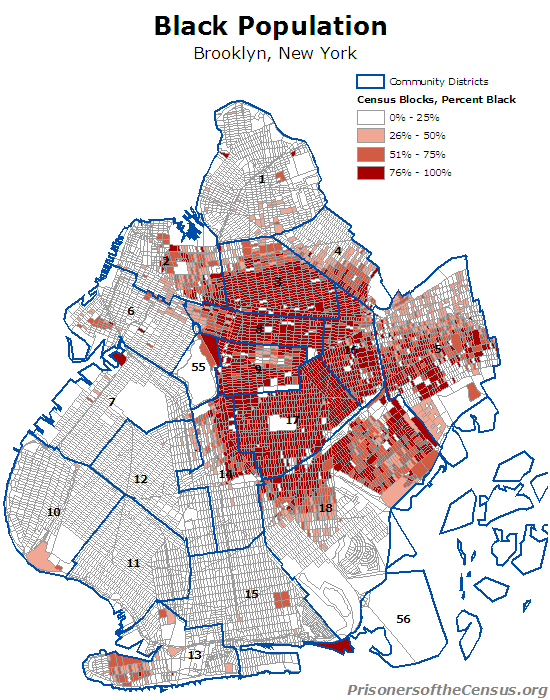Demographics of Brooklyn
Brooklyn is with 2.5047 million inhabitants (as of April 1, 2010) the largest of the five boroughs of New York City. With a land area of 182.9 km ², this corresponds to a population density of 13,694 inhabitants per km ². The annual population growth is 0.16 percent ( average 2000-2010).
Population Development
The area of present-day Brooklyn experienced strong population growth in the 19th and early 20th centuries. The towns in Kings County had at the beginning of the 19th century together about 6000 inhabitants. When Brooklyn was incorporated in 1898 after a plebiscite to New York, it already had more than one million inhabitants. 30 years later, the population reached 2.5 million. As a result, the growth rate decreased significantly until the population in 1950 to 2.74 million reached its historical peak. The subsequent decline in population amounted to 1980 to a total of nearly a fifth. Since then, the population is again increasing slightly, so that today it has almost returned to the levels of 1930. Brooklyn Manhattan has measured the number of inhabitants in the mid 1920s and has since overtaken the largest of the five New York boroughs.
Growth = average annual population growth
Sources: 1698-1771, 1790-1990, 2000, 2010
Populations and origin
In Brooklyn a number of different population groups that reflect all waves of immigration in the United States live. The first settlers were Dutch and British, and later immigrated German and Italian. As part of the Great Migration attracted increasingly from the mid-20th century, many former black slaves from the southern states and Puerto Ricans to Brooklyn. In recent decades, however, most migrants come from other countries in the Caribbean as well as Asia and Eastern Europe. Due to the still high level of immigration are now 40.1 percent of all residents born outside the United States (ACS 2009). As is usually common in the United States each population or groups of origin also live in Brooklyn largely spatially separated in their own neighborhoods. While the southern and western Brooklyn is dominated by whites, live in the north and east, mainly African-Americans and Hispanics.
With a share of 42.8 percent of whites are the largest ethnic group, make of non- Hispanic whites 35.7 percent ( Census 2010). This Brooklyn is a so-called Majority - Minority County, which means that non- Hispanic whites in this county make up less than half of the population. The most common European origin groups are Italians with 157,000 people ( 6.1 percent of the population), 101,000 Russians ( 3.9 percent ), 88,800 Irish ( 3.5 percent), 71,100 Poles (2.8 percent), 53,200 German (2, 1 percent), 36,200 British, 29,100 Hungarians, 24,500 Ukrainians, 17,300 French, 14,500 Greeks, 11,200 Romanians and 11,100 Scots and, among others 5,900 2,500 Austrians and Swiss. Furthermore, living in Brooklyn 43,600 Arabs ( including many Egyptians and Syrians ) and 14,600 Israelis who are also counted among the whites ( ACS 2009).
The residential areas of European -Americans focus on the southern and western parts of the city of Brooklyn. The highest proportion of non-Hispanic whites, the Community District 15 with 75.5 percent, the lowest of the Community District 16 with 0.7 percent ( Census 2000). Italian Americans are the majority in the districts of Bensonhurst, Gravesend and Bay Ridge. In contrast, Brighton Beach and Sheepshead Bay of Russian - Americans, Gerritsen Beach and Marine Park of Irish- Americans and Greenpoint Greenwood Heights dominated by Polish- Americans. Regardless of national origin includes over 40 percent of non- Hispanic whites in the Jewish faith. Jews comprise the majority of the population in the districts of Borough Park and Midwood.
34.3 percent of residents are black and African Americans, including 31.9 percent of non- Hispanic blacks ( Census 2010). After origin groups are 12.6 percent of the population of West Indians, including 89,400 Jamaicans ( 3.5 percent), 71,600 Haitians (2.8 percent), 50,800 Trinidadians and Tobagoer and 17,300 Barbadians. In Brooklyn also live 60,100 immigrants from sub-Saharan Africa (ACS 2009). The highest proportion of blacks, the Community District 17 with 88.4 percent, the lowest of the Community District 11 with 0.4 percent ( Census 2000). The traditional cultural center of African-Americans in Brooklyn 's Bedford -Stuyvesant neighborhood of where they represent the majority of the population since the 1930s after the construction of the A- line of the metro link between Harlem and Bedford. More African-American majority districts in the northern and eastern Brooklyn, which all are around Bedford -Stuyvesant around, are Brownsville, Canarsie, Crown Heights, East Flatbush, Prospect Lefferts Gardens, East New York and Fort Greene. Black put in these districts together account for about 940,000 inhabitants, or 82 percent of the population. This is the largest predominantly African-American area of settlement in the United States. Apart from making black all over Brooklyn for a significant proportion of residents in social housing.
19.8 percent of the residents of Brooklyn are Hispanics or Latinos ( Census 2010). After skin colors, these are 9.7 percent White, 1.6 percent Black, 0.7 percent have been assigned to another and the remaining 7.6 percent, none of the specified breeds. Puerto Ricans are 190,000 people (7.4 percent of population) among Hispanics the largest and traditionally most important group of origin. Also among the Latinos among the 95,000 living in Brooklyn Dominicans, Mexicans 91,200, 28,900 Ecuadorians, Colombians 12,900, 12,700 and 12,500 Salvadorans and Panamanians, among others, 7,000 Spaniards (ACS 2009). The neighborhoods that are now predominantly inhabited by Hispanics, are located in the east and northeast of Brooklyn and were previously characterized African American, these include Bushwick, East Williamsburg and Cypress Hills. Also in Sunset Park in southern Brooklyn home to many Latinos. The highest proportion of Hispanics, the Community District 4 with 67.2 percent, the lowest of the Community District 15 with 6.4 percent ( Census 2000).
Asians are the fastest growing population group, which is now 10.5 percent of the population of Brooklyn is ( Census 2010). Among them are Chinese with 163,000 persons ( 6.4 percent ) far the most significant group are further 19,900 Indians, 15,800 Pakistanis, 9,700 Filipinos, 7,000 Koreans, 7,000 Bangladeshis, 5,700 Vietnamese, and 4,700 Japanese (ACS 2009). The highest proportion of Asians (including Pacific Islanders ), the Community District 11 with 23.0 percent, the lowest of the Community District 16 with 0.6 percent ( Census 2000). Especially many Asians live in southern Brooklyn, in neighborhoods like Sunset Park and Homecrest.
In the 20th century, significant changes in the population composition took place in Brooklyn. Was inhabited almost exclusively by whites While the municipality at the beginning of the century (1910: 99 percent), their share declined by 2000 to 41 percent (including white Hispanics ). The proportion of blacks, however, increased from (1910 ) 1 percent (1990 ) 38 per cent. While the West and South of the borough is still home to mainly by whites, an almost complete replacement of the resident population was held by the immigration of blacks and later Hispanics in the east and north. Set around Bedford -Stuyvesant neighborhood as Brownsville, Canarsie and East New York had previously been dominated by Italians and Jews until they switched to an African -American and Puerto Rican population majority. This migration took place mainly in the 1950s to the 1970s, as with immigration of blacks and Hispanics increased social problems and a total of nearly 500,000 mainly white residents left Brooklyn. Most moved to Queens, Staten Iceland or in counties of Long Iceland and New Jersey.
The following tables show the data on the population of Brooklyn in detail information is supplied, the results of examinations of the United States Census Bureau.
1) The U.S. Census Bureau distinguishes the two ethnic groups Hispanics and non - Hispanics ( Hispanic or Not Hispanic ); non - Hispanics are further here by skin color ( Races ) divided; 2) Persons who have not associated with the given skin colors
Sources: 2010, 2000, 1990, 1980
1) People who have not associated with the given skin colors; 2) proportion of black slaves in the total population
Sources: 2010, 2000, 1990, 1820-1980
1) possible mixed origin with multiple entries ( Total Ancestry Reported ); 2) excluding Puerto Ricans, Dominicans and Cubans; 3) Persons who stated as origin only " West Indies "; 4) Anguilla, Antigua and Barbuda, British Virgin Islands, Dominica, Montserrat, St. Kitts and Nevis, Saint Lucia, Saint Vincent and the Grenadines and Turks and Caicos Islands; 5) including people who say " Northern Irish " as the origin; without people, specify the " Scotch- Irish "; 6) Persons who stated as origin " American " or "United States"; 7) without Austrians, Swiss, Pennsylvania Dutch and German Russia; 8) Persons who stated as origin only "European"
Sources: ACS, 2000, 1990
1) excluding persons who were born abroad or on the high seas of American parents; 2) Albania, Bosnia and Herzegovina, Bulgaria, Croatia, Latvia, Lithuania, Macedonia, Moldova, Poland, Romania, Russia, Serbia, Slovakia, Czech Republic, Ukraine, Belarus and others; 3) without West Indies; 4) including Afghanistan and Iran; 5 ), including Turkey, Iran without
Sources: ACS, 2000, 1990
1) Native; 2) Naturalized U.S. citizen; 3) Not a U.S. citizen
Sources: ACS, 2000, 1990
Languages
Brooklyn exhibits a high diversity of language. English is the half of the population ( 54.8 percent) the first language for good. The second most important language is Spanish, which is used by 16.9 percent at home. The remaining 28.3 percent is distributed to numerous other languages, including Chinese and 6.0 percent, 5.6 percent Russian.
Overall indicate 75.8 percent of the residents of Brooklyn, to use English as a first or second language. Correspondingly, the proportion of people who are not very good at English is, with 24.2 percent more than the U.S. average ( 8.6 per cent ). The distribution of English language skills is among the populations differ greatly. Values of more than 90 percent of the native English speakers and more than 98 percent of all persons who dominate English very well, reaching only origin groups from anyway English-speaking countries such as the English, Irish, Jamaican and Guyanese. Also have African-American, German and Italians relatively good knowledge of English. The rarest English from Chinese, Ecuadorians, Dominicans and Mexicans is spoken. In these groups, the proportion of native speakers is below 10 percent, including bilinguals below 50 percent.
1) language that is spoken at home ( Language spoken at home), population aged 5 and over; 2) Proportion of people at home who speak only English; People who speak at home both English and another language, the other language must be allocated exclusively; 3) including Spanish Creole; 4) mainly Haitian; 5) including Patois and Cajun; 6), including French Creole
Sources: ACS, 2000, 1990
1) Percentage of persons aged 5 years who only speak English at home; 2) Percentage of persons aged 5 years who speak English very well; 3) Without Hispanics; 4 ) the total population of New York City; 5 ) the total population of the United States
Source: ACS 2007-2009
Religions
The largest denomination in Brooklyn, the Roman Catholic Church with a population share of 37 percent dar. Another 15 percent of the population are Jews and 9 percent Protestants of different directions. 37 percent of respondents are non-denominational or none of the religions covered wanted to assign.
Source: Association of Religion Data Archives
Economic Situation and Education
Brooklyn is one of the structurally weaker counties in the United States. The per capita income is $ 23,370 with 14 percent below the national average and even 24 percent below the average of New York City. In addition, the wealth among the different population groups is very unevenly distributed. Whites are by far the largest group on average. The income of blacks and Asians are mostly below the national average, while Hispanics are still significantly poorer. After Origin English are the wealthiest and poorest Mexicans, the former being on average earn almost five times more than the latter. All non-European origin groups have income below the national average.
The unemployment rate is similar to that in the United States and in New York City with 7.9 percent. The lowest unemployment prevails among Mexicans ( 4.7 percent ), the highest among blacks ( 10.4 percent ) and Puerto Ricans ( 11.6 percent). The proportion of people living below the poverty line, is in Brooklyn with 21.5 percent is far higher than the American average ( 13.6 percent). Most commonly, Hungary affected by poverty ( 44.7 percent) and least common in Ireland ( 8.6 per cent ) and English ( 9.7 percent).
The level of education in Brooklyn is measured by the degrees about the American average. Of the persons aged 25 and over have a 77.5 percent high- school graduation (U.S.: 84.9 percent) and 28.7 percent have a bachelor's degree (U.S.: 27.8 percent). White generally have the best, the worst Hispanics school education. Blacks have a solid high school education, but rarely a bachelor's degree on average. Asians have below average often have a high school degree, but are at the higher bachelor's degrees almost in the general population. Of the origin groups for which statistics have English and German in terms of both high school and bachelor's degree, the best, the worst Mexicans each training. English have all had average good eight times as often a bachelor's degree as Mexicans.
1) Income of the past twelve months in inflation-adjusted 2009 U.S. dollars; 2) average income of the total population = 100; 3) Share of unemployed civilian labor force; 4) Proportion of people below the poverty line; the poverty line is redefined annually; 5) Percentage of persons aged 25 years with high school degree or a higher degree; 6) Percentage of persons aged 25 years with a bachelor 's degree or an advanced degree; 7) without Hispanics; 8 ) the total population of New York City; 9 ) the total population of the United States
Source: ACS 2007-2009










